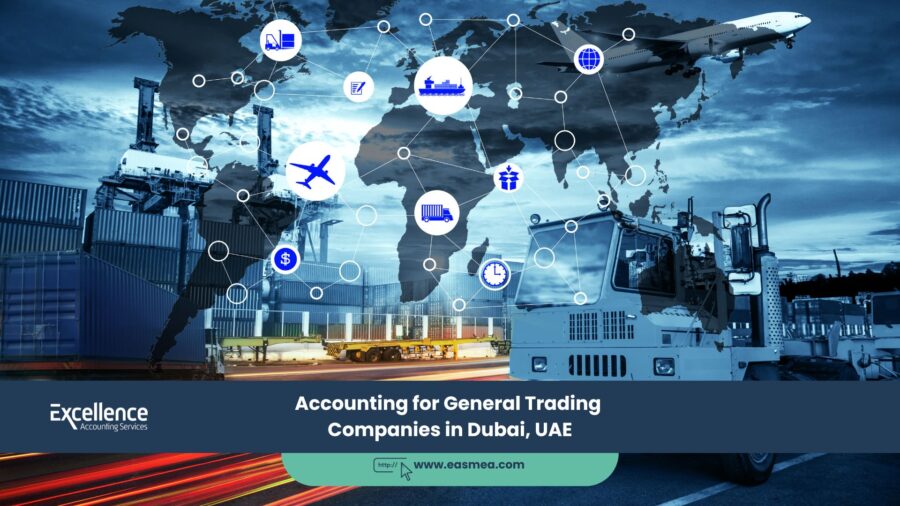Dubai’s strategic location as a gateway between East and West has cemented its status as a global trading powerhouse. General trading companies are the lifeblood of this ecosystem, facilitating the import, export, and re-export of a vast array of goods across the world. While the business of trading is dynamic and full of opportunity, it is also a margin-driven industry where financial precision is not just an advantage—it’s essential for survival.
Accounting for a general trading company in Dubai is a complex discipline that revolves around the meticulous management of inventory, the complexities of international logistics, and the constant fluctuation of currencies and costs. Profitability is a direct result of buying smart, managing stock efficiently, controlling supply chain costs, and navigating a landscape of customs, VAT, and corporate tax regulations. Without a robust accounting framework, profits can be quickly eroded by hidden costs, poor inventory control, and compliance missteps.
This definitive guide provides a strategic blueprint for Accounting for General Trading Companies in Dubai, UAE. We will explore the critical financial practices for the trading sector, from the nuances of inventory valuation and landed cost calculation to the management of multi-currency transactions. We will also provide clarity on the application of VAT and the new UAE Corporate Tax to trading operations, ensuring your business is both compliant and financially optimized.
Whether you trade in electronics, textiles, foodstuffs, or machinery, this guide will equip you with the financial knowledge to build a resilient and highly profitable trading enterprise. We will cover industry best practices, essential financial controls, and the reporting that builds confidence with suppliers, customers, banks, and regulatory authorities.
Key Takeaways
- Inventory is Your Core Asset: The primary challenge is managing the cost, valuation, and movement of physical stock. A robust inventory management system is non-negotiable.
- Calculate the “Landed Cost”: The true cost of your inventory is not just the purchase price; it’s the “landed cost,” which includes shipping, insurance, customs duties, and clearance fees.
- Gross Margin is the Key Metric: Profitability is driven by the gross margin (Sales Revenue minus Cost of Goods Sold). Meticulous tracking of this metric is essential.
- Multi-Currency Management is Standard: Buying and selling in different currencies (e.g., USD, EUR, CNY) is common, requiring strong systems to manage foreign exchange (FX) risk.
- VAT, Customs, and Corporate Tax: Navigating the rules of Dubai Customs, the specific VAT treatment for imports and exports, and the 9% Corporate Tax are critical for compliance and profitability.
The Financial Anatomy of a General Trading Company
A general trading company is essentially a sophisticated wholesaler and distributor. The business model is built on sourcing products from one market and selling them in another, earning a profit on the margin. Success depends on strong supplier relationships, efficient logistics, astute market knowledge, and, most importantly, tight financial control over the entire supply chain.
Operating in Dubai means leveraging world-class logistics infrastructure, including Jebel Ali Port and Al Maktoum International Airport. It also means working within a well-defined regulatory framework for trade, governed by bodies like Dubai Customs. Your accounting system must be able to integrate these complex logistical and regulatory costs into your financial reporting.
Core Principles of Accounting for General Trading Companies in Dubai, UAE
The fundamental principle of accounting for general trading companies in Dubai, UAE, is the accurate valuation and tracking of inventory. Your balance sheet and income statement are both dominated by the flow of goods. Getting this right is the key to understanding your true financial position and profitability.
This requires a perpetual inventory system, where stock levels and costs are updated in real-time as goods are bought and sold. This provides the visibility needed to manage your business effectively in a fast-moving market.
Inventory Management and Valuation
Your inventory is your primary asset and your biggest investment. Your accounting system must be able to track not just the quantity of each item but also its cost. There are several methods for costing inventory, with the most common being:
- First-In, First-Out (FIFO): Assumes that the first units purchased are the first ones sold. This is a common and logical method for most goods.
- Weighted Average Cost: Calculates a new average cost for all items in stock after each new purchase. This method smooths out price fluctuations.
The choice of method can have a significant impact on your reported profit and the value of inventory on your balance sheet. Whichever method you choose, it must be applied consistently. A professional bookkeeping service can help you implement the right inventory accounting system.
A Closer Look at Accounting for General Trading Companies in Dubai, UAE
Profitability in trading is all about the margin. To protect that margin, you must have a precise understanding of all the costs associated with getting your product from the supplier’s factory to your customer’s warehouse. This is a complex calculation that goes far beyond the simple purchase price.
In trading, the price you pay your supplier is only the beginning of the story. The true cost is only known once the goods have landed in your warehouse.
This is where the concept of “landed cost” becomes the most important calculation in your accounting process.
Calculating the True Cost: Landed Cost
The landed cost of a product is its total cost up to the point it arrives at your warehouse door. It includes the original purchase price plus all the associated supply chain costs. A failure to accurately calculate and allocate these costs will lead to a dangerously inaccurate understanding of your gross profit.
| Landed Cost Component | Description | Accounting Treatment |
|---|---|---|
| Purchase Price | The actual price paid to the supplier (FOB – Free on Board). | The base cost of the inventory item. |
| Freight & Shipping | Sea freight or air freight charges to transport the goods to Dubai. | Added to the cost of the inventory. |
| Insurance | Insurance costs to cover the goods during transit. | Added to the cost of the inventory. |
| Customs Duty & Clearance | Any import duties, customs fees, and charges from your clearing agent. | Added to the cost of the inventory. |
| Local Transport | The cost of trucking the goods from the port to your warehouse. | Added to the cost of the inventory. |
Your accounting system must be able to take all these different costs from different suppliers (shipping line, insurance company, clearing agent) and allocate them accurately to the specific shipment of inventory they relate to. This gives you the true landed cost per unit, which then becomes the basis for your Cost of Goods Sold (COGS) calculation when you sell the product.
Navigating Tax and Customs in Dubai
As a trading hub, Dubai has a well-established but strict framework for customs and tax. A general trading company must be an expert in navigating these rules to ensure smooth operations and full compliance. For the most authoritative guidance, you should always refer to the official websites of the Federal Tax Authority (FTA) and Dubai Customs.
VAT on Imports and Exports
The application of VAT to the trading of goods is a key area of focus.
- Imports: When you import goods into the UAE, 5% VAT is typically payable at the time of customs clearance. As a VAT-registered business, you can then reclaim this input VAT on your next VAT return. Many businesses use a tax agent or clearing agent who can defer the payment of this VAT, which is a significant cash flow benefit.
- Local Sales: When you sell goods to a customer within the UAE, you must charge 5% VAT on the sale.
- Exports: When you export goods to a customer outside the UAE, this is a zero-rated supply. This means you do not charge VAT to your customer, but you can still reclaim the input VAT you paid on your costs related to those goods. You must retain official export documentation (like an exit certificate and bill of lading) as proof.
A meticulous system for VAT accounting and filing is essential to manage these different scenarios correctly.
Corporate Tax for Trading Companies
Your trading company will be subject to the 9% UAE Corporate Tax on its annual taxable profits exceeding AED 375,000. Your taxable profit is your gross profit (Sales minus Cost of Goods Sold) less your operating expenses (salaries, rent, marketing, etc.). The accuracy of your landed cost and inventory valuation directly impacts your COGS, and therefore has a huge effect on your taxable profit. Maintaining complete and organized records for every transaction is mandatory. Professional corporate tax services are vital for ensuring you meet these complex requirements.
What Excellence Accounting Services Can Offer
At Excellence Accounting Services (EAS), we have extensive experience in the import/export and trading sectors that are the lifeblood of Dubai’s economy. We understand the financial complexities you face, from inventory management to multi-currency trade. We offer specialized accounting services to provide the financial control and insight you need to succeed.
Our specialized offerings for general trading companies include:
- Inventory Accounting Systems: We help you implement and manage robust systems for tracking inventory, calculating landed costs, and valuing your stock according to IFRS.
- Multi-Currency Accounting: Our systems are designed to handle transactions in multiple currencies, and we can provide advice on managing your foreign exchange exposure.
- Profitability and Margin Analysis: We provide detailed reporting on your gross profit margins by product line, customer, or market, giving you the insights to make better business decisions.
- VAT, Customs, and Corporate Tax Compliance: Our tax experts specialize in the trading sector, managing all your compliance needs and helping you navigate the complexities of import and export regulations.
- Virtual CFO Services: Get high-level strategic guidance on trade finance, cash flow management, and business expansion. For more details, see our Virtual CFO services.
By partnering with EAS, you gain a financial team that understands the global flow of trade. We handle the financial complexity so you can focus on sourcing and selling.
Frequently Asked Questions (FAQs)
These are Incoterms that define who is responsible for costs during shipping. FOB (Free on Board) means your responsibility (and cost) begins when the goods are loaded onto the ship at the origin port. You are responsible for paying for the sea freight and insurance. CIF (Cost, Insurance, and Freight) means the supplier’s price includes the cost of the goods, the insurance, and the sea freight to your destination port. Understanding these terms is crucial as it determines which costs you need to arrange and pay for, and which are already included in your supplier’s price.
This is why you have cargo insurance. When goods are damaged, you should first file a claim with your insurance company. From an accounting perspective, the cost of the damaged goods must be written off from your inventory. You would record an expense for the loss. When you receive the payment from the insurance company, this is recorded as “Other Income” (e.g., “Insurance Claim Proceeds”).
A Letter of Credit is a financial instrument issued by a bank that guarantees payment to a supplier on your behalf, provided they meet certain conditions (like providing proof of shipment). It is often used in international trade to provide security to both the buyer and the seller. When your bank issues an LC, it creates a liability for you. The accounting involves tracking this liability and the eventual payment. LCs have associated bank fees, which are a deductible business expense.
This creates foreign exchange (FX) exposure. The simplest way to manage this is to get a real-time exchange rate when you are quoting your customer and include a small buffer (e.g., 1-2%) in your price to protect against minor fluctuations. For very large orders, you can use a “forward exchange contract” with your bank. This allows you to lock in a specific CNY/USD exchange rate for a future date, completely eliminating the currency risk for that transaction.
Yes. This is a major advantage of operating in Dubai. You can import goods and store them in a bonded warehouse within a free zone like the Jebel Ali Free Zone (JAFZA). You do not have to pay the 5% customs duty as long as the goods remain in the free zone. You only pay the duty if you decide to move the goods out of the free zone to sell them into the mainland UAE market. If you re-export the goods directly from the free zone to another country, no UAE customs duty is payable at all. This is a key strategy for re-export businesses.
Both are crucial shipping documents. The Commercial Invoice is the primary financial document. It details the buyer, seller, price of the goods, currency, payment terms, and is used by customs to determine the value of the goods for duty calculation. The Packing List is a logistical document. It details the physical contents of the shipment, including the number of boxes, the weight, and the dimensions of the cargo. It does not typically show prices. It is used by the shipping line, port handlers, and your warehouse team to handle the cargo correctly.
Companies in a UAE Free Zone may be eligible for a 0% Corporate Tax rate, but only on their “Qualifying Income.” The definition of Qualifying Income is complex. Generally, income from trading with companies outside the UAE or with other companies within the same or another free zone is considered qualifying. However, selling goods to mainland UAE customers from a free zone is generally subject to the standard 9% Corporate Tax rate. The rules are detailed, and obtaining professional tax advice is essential to ensure you are compliant.
This is a “Sales Return.” You would issue a credit note to the customer, which reduces your revenue and your accounts receivable. When you receive the physical goods back, you need to assess their condition. If they can be repaired and resold, they go back into your inventory at their cost. If they are damaged beyond repair, you must “write off” the cost of the goods, recording it as an expense.
The most common reason is a mismatch between payment cycles. Trading companies often have to pay their international suppliers upfront or very quickly (e.g., upon shipment) to get the goods released. However, they may offer 30, 60, or 90-day credit terms to their own customers. This means their cash is tied up for a long period in inventory and accounts receivable. Without sufficient working capital or access to trade finance facilities, this cash flow gap can become a major crisis, even for a profitable company.
Gross Profit Margin (Revenue – Cost of Goods Sold) / Revenue is the most important measure of the core profitability of your trading activity. It shows how much profit you make from buying and selling goods before your overheads are even considered. A company might have high revenue, but if its gross margin is very low, it may not be making enough profit to cover its operating expenses (salaries, rent, etc.). Constantly monitoring your gross margin by product, supplier, and customer allows you to make strategic decisions to improve profitability, such as finding lower-cost suppliers, focusing on higher-margin products, or renegotiating prices with customers.
Conclusion: Charting a Course for Trading Success
In the global marketplace of Dubai, a general trading company is a vital link in the chain of commerce. While success is driven by market knowledge and logistical skill, long-term profitability is secured by a foundation of robust financial discipline. An accounting framework that provides a true and accurate picture of your inventory, landed costs, and margins is not just a compliance tool—it is your most critical strategic asset.
By mastering the complexities of inventory valuation, managing multi-currency transactions with foresight, and maintaining unwavering compliance with the UAE’s customs and tax authorities, you build a business that is both resilient and profitable. This financial clarity empowers you to negotiate with confidence, manage risk effectively, and navigate the complexities of international trade. In the world of buying and selling, sound accounting is what ensures you are always making a profit.
From Sourcing to Sales. From Cost to Profit.
Let Excellence Accounting Services provide the specialized financial management and industry insight your business needs to succeed in the UAE and beyond.




